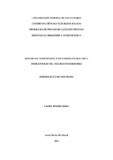| dc.creator | Quines, Caroline Brandão | |
| dc.date.accessioned | 2015-02-24 | |
| dc.date.available | 2015-02-24 | |
| dc.date.issued | 2013-08-05 | |
| dc.identifier.citation | QUINES, Caroline Brandão. Study of toxicology and pharmacology of 2-phenylethynyl butyltellurium in rodent. 2013. 69 f. Dissertação (Mestrado em Ciências Biológicas) - Universidade Federal de Santa Maria, Santa Maria, 2013. | por |
| dc.identifier.uri | http://repositorio.ufsm.br/handle/1/11223 | |
| dc.description.abstract | The organotellurium compounds have been the subject of research due to their pharmacological and toxicological properties. It is believed that the main mechanism involved in the toxicity of these compounds is the ability to interact with sulfhydryl groups from molecules biologically active. Beyond the toxicological effects, some pharmacological properties have been attributed to organotellurium compounds. This study aimed to investigate the potential toxicological and pharmacologic of 2-phenylethynyl-butyltellurium (PEBT) through experiments in vitro and in vivo in rodents. To evaluate the toxicological effect the PEBT was used at different concentrations in the oxidation of mono and dithiols and analysis of enzyme Na+K+ -ATPase and lactate dehydrogenase in vitro. Furthermore, lethality studies were performed to calculate the LC50 LD50 of this compound and for better understanding their toxicity. To evaluate the pharmacological effect the PEBT was used at a dose of 1mg/kg 30 minutes before the behavioral experiments, evaluation of locomotor activity, forced swim test (FST) and the tail suspension test (TST), immediately after testing the cerebral cortex was removed for analysis of monoamine oxidase (MAO) enzyme. The results showed that the PEBT oxidized thiols of low molecular weight and inhibits the activity of the enzyme Na+K+ - ATPase by oxidation of sulfhydryl groups, and such oxidation is dependent on the tellurium atom in the structure of this compound. Moreover, the acute administration of PEBT showed an antidepressant-like effect on TNF in mice, as well inhibits the activity of MAO-A enzyme in the cerebral cortex, demonstrating the involvement of this enzyme in its antidepressant-like effect. | eng |
| dc.description.sponsorship | Coordenação de Aperfeiçoamento de Pessoal de Nível Superior | |
| dc.format | application/pdf | por |
| dc.language | por | por |
| dc.publisher | Universidade Federal de Santa Maria | por |
| dc.rights | Acesso Aberto | por |
| dc.subject | Telúrio | por |
| dc.subject | Enzimas sulfidrílicas | por |
| dc.subject | Oxidação de mono e ditiois | por |
| dc.subject | Na+K+ -ATPase | por |
| dc.subject | Monoamino oxidase | por |
| dc.subject | Ratos | por |
| dc.subject | Tellurium | eng |
| dc.subject | Sulfhydryl enzymes | eng |
| dc.subject | Oxidation of mono-and dithiols | eng |
| dc.subject | Na+K+ -ATPase | eng |
| dc.subject | Monoamine oxidase | eng |
| dc.subject | Rats | eng |
| dc.title | Estudo da toxicologia e da farmacologia do 2-feniletinilbutil-telúrio em roedores | por |
| dc.title.alternative | Study of toxicology and pharmacology of 2-phenylethynyl butyltellurium in rodent | eng |
| dc.type | Dissertação | por |
| dc.description.resumo | Os compostos orgânicos de telúrio têm despertado o interesse dos pesquisadores, devido as suas propriedades farmacológicas e toxicológicas. Acredita-se que o principal mecanismo envolvido na toxicidade desses compostos, seja a capacidade de interagir com os grupamentos sulfidrílicos de moléculas biologicamente ativas. Além dos efeitos toxicológicos, propriedades farmacológicas vêm sendo atribuídas aos compostos orgânicos de telúrio. Esse estudo teve como objetivo investigar o potencial toxicológico e farmacológico do 2- feniletinilbutil-telúrio (PEBT), através de experimentos in vitro e in vivo em roedores. Para a avaliação toxicológica, o PEBT foi utilizado em diferentes concentrações na oxidação de mono e ditiois e na determinação da atividade das enzimas Na+K+ -ATPase e lactato desidrogenase, in vitro. Ainda nesse sentido estudos de letalidade foram realizados para calcular a CL50 e DL50 desse composto para melhor compreender a sua toxicidade. Para a avaliação farmacológica, o PEBT foi administrado em camundongos, na dose de 1 mg/kg 30 minutos antes dos experimentos comportamentais, avaliação da atividade locomotora, teste do nado forçado (TNF) e teste de suspensão da cauda (TSC). Após os testes comportamentais, os animais foram mortos e o córtex cerebral foi retirado para determinação da atividade da enzima monoamina oxidase (MAO). Os resultados mostraram que o PEBT oxida tióis de baixo peso molecular e inibe a atividade da enzima Na+K+ -ATPase, pela oxidação de seus grupamentos sulfidrilicos, sendo essa oxidação depende da presença do átomo de telúrio na estrutura do composto. Além disso, a administração aguda do PEBT produz um efeito do tipo antidepressivo no TNF em camundongos, bem como inibe a atividade da enzima MAO-A em córtex cerebral, demonstrando o envolvimento dessa enzima no seu efeito do tipo antidepressivo. | por |
| dc.contributor.advisor1 | Nogueira, Cristina Wayne | |
| dc.contributor.advisor1Lattes | http://lattes.cnpq.br/2877042401245169 | por |
| dc.contributor.referee1 | Wagner, Caroline | |
| dc.contributor.referee1Lattes | http://lattes.cnpq.br/4004565241849091 | por |
| dc.creator.Lattes | http://lattes.cnpq.br/7387078165930666 | por |
| dc.publisher.country | BR | por |
| dc.publisher.department | Bioquímica | por |
| dc.publisher.initials | UFSM | por |
| dc.publisher.program | Programa de Pós-Graduação em Ciências Biológicas: Bioquímica Toxicológica | por |
| dc.subject.cnpq | CNPQ::CIENCIAS BIOLOGICAS::BIOQUIMICA | por |


